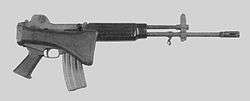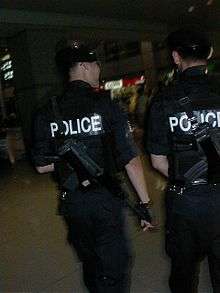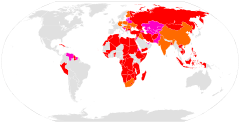Daewoo Precision Industries K2
| Daewoo Precision Industries K2 | |
|---|---|
 The Daewoo Precision Industries K2 assault rifle | |
| Type | Assault rifle |
| Place of origin | Republic of Korea |
| Service history | |
| In service | 1984–present |
| Used by | See Users |
| Wars |
Gulf War War in Afghanistan[1] Iraq War[1] Conflict in the Niger Delta 2006 Fijian coup d'état Iraqi insurgency |
| Production history | |
| Designer |
Agency for Defense Development S&T Motiv |
| Designed | 1972–1983 |
| Manufacturer | S&T Motiv[2] |
| Unit cost | US $727.00[3] |
| Produced | 1982–present |
| Variants | See Variants |
| Specifications | |
| Weight | 3.26 kg (7.2 lb) |
| Length |
980 mm (39 in) (extended) 730 mm (29 in) (folded) |
| Barrel length | 465 mm (18.3 in) |
|
| |
| Cartridge |
5.56×45mm NATO .223 Remington |
| Action | Gas operated, Rotating bolt (long-stroke piston) |
| Rate of fire | 750 RPM |
| Muzzle velocity |
920 m/s (3,000 ft/s) (K100) 960 m/s (3,100 ft/s) (KM193) |
| Effective firing range |
600 m (K100) 460 m (KM193) |
| Maximum firing range |
3,300 m (K100) 2,653 m (KM193) |
| Feed system | Various STANAG Magazines. |
| Sights | Iron sights |
Daewoo Precision Industries K2 assault rifle was developed by the South Korean Agency for Defense Development and manufactured by S&T Motiv (formerly Daewoo Precision Industries). It is currently the standard service rifle of the Republic of Korea Armed Forces. Shoulder-fired and gas-operated, the K2 is capable of firing both 5.56×45mm NATO and .223 Remington ammunition. The K2 supplanted the M16A1 assault rifle for the Republic of Korea Armed Forces since its adoption in 1984.[4]
Development

In the 1960s, the South Korean armed forces relied completely upon military support from the United States to supply its small arms, consisting mostly of M1 Garands and M1/M2 carbines. Attempts at the time to develop an indigenous rifle were hampered by the country's economic, technological, and industrial shortcomings, and initial attempts never went into production. During South Korean involvement in the Vietnam War, South Korean army soldiers and marines received the more modern M16A1 assault rifle from U.S. military aid, though not enough to arm all active military personnel. With a modern rifle design and rapid economic growth in the 1970s, South Korea began to build the M16A1 under license in 1974.[5]
Despite being able to produce their own service rifle, it was not an ideal arrangement; the original license agreement did not cover enough weapons to equip their forces including millions of reserves, and having to pay license fees to manufacture the design was too expensive at a time when the country was short on foreign currency. Geopolitical considerations played a factor, as the Nixon Doctrine and Carter administration's use of the U.S. military presence on the Korean peninsula as leverage to force change against South Korea's human rights practices. Under such influences, South Korea felt it necessary to be able to control their own basic weapon needs.[5] Facing the eventual expiration of the Republic of Korea's license to produce the M16A1 (Colt Model 603K), president Park Chung-hee, who strongly believed in self-reliance in national defense, ordered the development of an indigenous standard military firearm.
An indigenous rifle program started in 1972. Initial requirements were for prototypes to be chambered in 7.62×51mm NATO, as at that point most 5.56×45mm ammunition was not domestically manufactured and was prioritized to be issued to front line troops, so sufficient quantities were not available for testing. Prototypes XB-1 through XB-5 were akin to AR-15-series rifles with some exterior changes; designers attempted to use as many M16 components as possible to save time and money, such as the direct gas impingement operation, sights, and handguards. By around 1976-77, the XB-6 prototype was chambered in 5.56×45mm, changed to a long-stroke gas piston operation in response to complaints about M16 reliability in Vietnam, and the recoil spring was moved to the upper receiver due to an Army requirement for a folding stock.[5]
By 1982-83, the final XB-7 prototype completed development and received official nomenclature of the K2 rifle. After field tests, it went into serial production in 1984. It was officially fielded in 1986 and made its first public appearance during the 1987 Armed Forces Day Parade.[5]
K2C
After the K2 was adopted, hardly any changes were made to the gun for nearly 30 years. There were several reasons for this: the ROK Army maintained a Cold War-style mentality that favored tanks and artillery against an outdated North Korean threat, leaving less money and urgency to modernize infantry weapons and tactics; the manufacturer had been producing tens of thousands of rifles each year since the 1970s without competition for domestic customers that didn't request upgrades, leaving no motivation to make changes; and various management and ownership changes created internal chaos making it difficult to conduct research and development. Special forces units had more of a need to upgrade K-series weapons with new optics and accessories, so they turned to private companies to develop add-on rail systems. Because they were being supplied many non-standard rails from various companies, the regular ROK Army standardized the MIL-STD-1913 rail in 2013 for the PVS-11K red dot sight, which on the K2 is only a short rail on the upper receiver, since it is made with an optics mount on the receiver to attach it and regular troops have less of a need for additional rails.[6]
The K2 and K1A had become outdated for international markets after 2000; in addition to lack of ability to add accessories, the K1A had become too large, underpowered, and un-ergonomic as a personal defense weapon or special operation carbine, and the K2 was too long. In 2012, S&T Motiv introduced the K2C, or K2 carbine. It has a shortened 13.5 in (340 mm) barrel with adjusted gas piston, detachable rear backup sight, flattop upper receiver with 4-way rail handguard, and right side-folding M4-style retractable stock; it weighs 3.3 kg (7.3 lb), is 875 mm (34.4 in) long with stock extended and 570 mm (22 in) with stock folded. The K2C has not been adopted by ROK forces, owing to continued insistence on 1980s-era small arms concepts that do not deem carbines appropriate for general infantry, but it has seen export sales.[6]
To enhance domestic appeal, S&T Motiv later created the K2C1, which retains the full-length K2's features (including bayonet lug) while utilizing the K2C's upgrades including a flattop upper receiver, M4-style adjustable stock, and optional rail handguard; as of 2016, it is in service in small numbers with front line troops. Partially due to the rail's screw attachment method, the K2C1 is slightly heavier than the original model (3.684 kg (8.12 lb) vs. 3.37 kg (7.4 lb)), and the rail tends to overheat due to the Army specifically refusing to have rail guards or vertical foregrips supplied with the rifles for inability to "comply with current bayonet fighting training manuals."[6]
Design

Six different prototypes were made during the XB development. Of the 6 designs, the XB6 was selected. Some parts of the XB6 resembled FN FNC such as the suppressor and sights. Further development of the XB6 evolved into the XB7 and finally the XB7C, also known as the XK2. Externally similar in appearance to the AR18, the K2 uses polymer for the forearm, pistol-grip and side-foldable buttstock. The fire control system and bolt carrier group are derived from the American M16 rifle,[7] but few of the parts, including the bolt and carrier, are interchangeable with the M16. The gas operating system is derived from the AKM. The K2 uses the same magazine as the M16. The barrel rifling has 6 grooves, 185 mm (1-in-7.3) right hand twist. The K2 has 3 selective firing modes: semi-auto, 3-round burst, and full automatic.
The K2 can be equipped with the DPI K201, an undercarried 40×46mm single shot grenade launcher patterned after the American M203.[1] The Republic of Korea Armed Forces originally planned to replace the entire K2 with new S&T Daewoo K11 dual-barrel air-burst weapon. However, high cost and skepticism over the effective firepower of the 20mm grenade led to the decision to provide 2 K11s to each squad, keeping 2 grenadiers as well. Consequently, the standard 9-person infantry squad of the Republic of Korea Armed Forces is currently equipped with 2 K2 rifles, 2 K2 rifles with K201 grenade launcher, 2 K11 DAWs, 1 K3 light machine gun, and the rest with either K1 or K2.
The K2 is also sometimes used with bipods and 4× magnification scopes, in a role similar to the Designated Marksman Rifle. A more modern way to accessorize the K2 and K1 is to mount a now (limited) standard issue PVS-4K Rail Integration System. It consists of an aluminum body with a long, uninterrupted rail for optical/red-dot and night-vision sights and three other rails located on the bottom and both sides. The rails are of the Picatinny-type.
K1 and K2 weapons systems
When personnel from the South Korean army special command were invited to see the XB-series prototypes, they requested the development of a new submachine gun to quickly replace a series of different weapons in their use. With no time to develop a new weapon, ADD made one based on the XB rifle prototypes called XB-S (short). It used a direct impingement gas tube rather than a piston to achieve the required short length, which was faster to make since they had short-barrel CAR-15 designs to work off of and no time to redesign a new short gas piston. The barrel used 1:12 inch rifling to fire M193 rounds, as during its development there were no plans to adopt SS109 ammunition in the South Korean army. The shortened design was adopted as the K1A SMG in 1981 and issued to special forces, commanders, radio operators, and others who needed a short SMG-like weapon.[5]
While the K1A SMG is commonly regarded as an SMG version of the K2, the K1 is a separate weapon altogether.[8] The primary differences between the two weapons include: development time and intent (the K1 took less time to develop and entered service sooner than the K2, and was developed originally as a submachine gun because it was intended to replace the M3 Grease Gun; the K2 was developed from the start as a service rifle); rifling (K1: 1-in-12 twist; K2: 1-in-7.3 twist); and gas system (the K1 uses a direct impingement gas system, while the K2 uses a long stroke gas piston system). In addition, parts are not interchangeable between the two weapons even though they can use the same cartridge (KM193 (.223 Remington) 5.56 caliber; the K2 can also utilize the K100 (SS109) 5.56 caliber round).
Variants
- XB: At least 6 versions (XB1 to XB6) of prototype were made.
- XB6: Selected design among the prototype.
- XB7: Further development of the XB6.
- XB7C: Final experimental prototype. Also known as XK2.
- K2: Mass-produced variant.
- AR-100: Semi-automatic 5.56×45mm NATO version for civilian market.
- DR-200: Semi-automatic .223 Remington version for civilian market.
- DR-300: Semi-automatic 7.62×39mm version for civilian market.
- K2A: Enhanced version featuring a Picatinny rail with foregrip and either foldable or extendable stock.[9]
- K2C (C="Carbine"): Carbine version of K2 rifle with Picatinny rail, M4-type buttstock, barrel reduced to 310 mm (12 in), and K11 suppressor.[10][9] Exports started in 2012.[11]
- K2C-1: A variant of the K2C which is under development, unveiled in ADEX 2017. Has a 16" barrel and has a firing range up to 500 meters with an Colt SCW-type buttstock, flip up sights, adjusted magwell, integrated picatinny rails and ambidextrous selector switches.[12]
- K2C-2: A variant of the K2C which is under development, unveiled in ADEX 2017. Has a 16" barrel and has a firing range up to 500 meters with an extendable buttstock, flip up sights, integrated picatinny rails and ambidextrous selector switches.[13]
- K2C1 (C="Exterior design changed without performance improvements", by the South Korean military weapon designation system.[14]) : New variant featuring a quad accessory rail, full-length 1913 Picatinny optics rail, an AR-15-style six position collapsing and foldable stock. Comes in two barrel lengths, 305 mm (12 in) and 465 mm (18.3 in).[15][16] It was officially sent into production in March 2016 with first deliveries in June 2016.[17]
Users















Non-State Actors
Replacement versus upgrades
S&T Daewoo (now S&T Motiv) proposed the XK8, a 5.56×45mm NATO bullpup version of the K2 in early 2000. After a series of field tests, the XK8 was rejected by the South Korean military and was never mass-produced.
More recently, the development of the S&T Daewoo K11 dual-barrel air-burst weapon, which uses 5.56×45mm NATO and 20×30mm air-burst grenade, prompted the South Korean military to plan for the replacements of all K2 rifles in service with the K11, making K11 the standard service rifle for the armed forces. However, due to the K11's extremely high cost and weight for a standard rifle, the armed forces scrapped its original plan and decided to provide 2 K11 per squad in order to increase firepower. The K2 was retained as the standard service rifle as a result.
In 2014, an upgraded K2 rifle, the K2A was introduced, and the South Korean Army is performing field tests. After the tests are complete, the K2A will be mass-produced and will join the armed forces in 2015. Additional production of K2 rifles will remove the M16A1 from active service completely by 2017.
See also
References
- 1 2 3 4 Wilk, Remigiusz. "Infantry Weapons: The Future Beckons for Asia" (PDF). Asian Military Review. Archived from the original (PDF) on July 7, 2011.
- ↑ "Business Outline, Defense Business". S&T Daewoo. Archived from the original on 2010-02-06. Retrieved 2010-07-01.
- ↑ "Daewoo Precision Industries K2 – Survival And Prosperity". survivalandprosperity.com. Retrieved 2014-01-11.
- ↑ "The 5.56 X 45mm: 1980-1985". The Gun Zone. Archived from the original on 2015-03-16. Retrieved 2008-10-30.
- 1 2 3 4 5 The Evolution of K1/K2 Families in the ROK Military - SAdefensejournal.com, 1 December 2017
- 1 2 3 K2C: South Korea’s Latest Carbine - SAdefensejournal.com, 29 September 2017
- ↑ "Daewoo K2 Assault Rifle". Gun's World. Retrieved 2008-10-30.
- ↑ Rifles n Guns' Daewoo K1 Page. Archived 2008-10-14 at the Wayback Machine. Retrieved on October 27, 2008.
- 1 2 Weapons of the Republic of Korea Marine Corps - SAdefensejournal.com, 4 September 2015
- ↑ "K계열 6가지 소총 직접 쏴보니". 아시아경제.
- ↑ S&T Motiv Defense Products catalog IDEX 2017, page 4.
- ↑ "Where Does S&T Motiv Go From Here? K2C-2 and K2C-1 Variants, Coyote Tan and SPW Stocks - The Firearm Blog". 20 November 2017.
- ↑ "S&T Motiv unveils new K2C-2 assault rifle at ADEX 2017 - Defence Blog". 19 October 2017.
- ↑ "K2소총 개량형 첫번째... 야전에 더욱 강해진 K2C1 - 1boon". Defense Media Agency. 8 September 2017.
- ↑ S&T Motiv Shows Off K2C1 Improved Daewoo Rifle at KDECIF 2016 - Thefirearmblog.com, 16 June 2016
- ↑ "DX Korea 2016- Modified K2C1 rifle, Korean Corner Shot - The Firearm Blog". 30 September 2016.
- ↑ http://www.janes.com/article/63604/dx-korea-2016-s-t-motiv-details-updated-roka-5-56-mm-service-assault-rifle
- ↑ Bangladesh Military Forces. "Bangladesh Navy Special Warfare Diving And Salvage (SWADS)". Retrieved 2010-01-14.
- ↑ "캄보디아 군대가 도입한 한국제군장비".
- 1 2 3 "[파워 경제인] 김택권 S&T대우 대표". 서울경제. 2011-09-15. Archived from the original on 2016-01-12.
- ↑ Capie, David (2004). Under the Gun: The Small Arms Challenge in the Pacific. Wellington: Victoria University Press. pp. 70–71. ISBN 978-0864734532.
- ↑
- 1 2 "Korean K2C in Iraq, on both sides - The Firearm Blog". 30 September 2016.
- ↑ "내년부터 軍장병 맞춤형 소총 보급". 아시아경제.
- ↑ "[펌]레바논군에서 사용하는 K2 RIS".
- ↑ "유용원의 군사세계". bemil.chosun.com. Retrieved 11 January 2014.
- ↑ Binnie, Jeremy; de Cherisey, Erwan (2017). "New-model African armies" (PDF). Jane's. Archived from the original (PDF) on 22 June 2017.
- 1 2 "한국의 무기 이야기". Segye.com. Retrieved 2014-02-21.
- ↑ "한국일보 : 나이지리아, K2 소총 3만정 수입키로". news.hankooki.com. Archived from the original on 12 December 2013. Retrieved 11 January 2014.
- ↑ "시사저널 - 북한 5만 특공대, 저공 침투 대기중". sisapress.com. 19 September 1996. Archived from the original on 3 June 2018.
- ↑ "대우 K2 - 나무위키". namu.wiki. Retrieved 2018-05-26.
- ↑ "S&T모티브, 멕시코, 파푸아뉴기니 軍․警에 총기 수출". S&T Motiv. April 10, 2013. Archived from the original on April 13, 2015.
- ↑ Archived May 25, 2009, at the Wayback Machine.
External links
| Wikimedia Commons has media related to Daewoo K2. |
